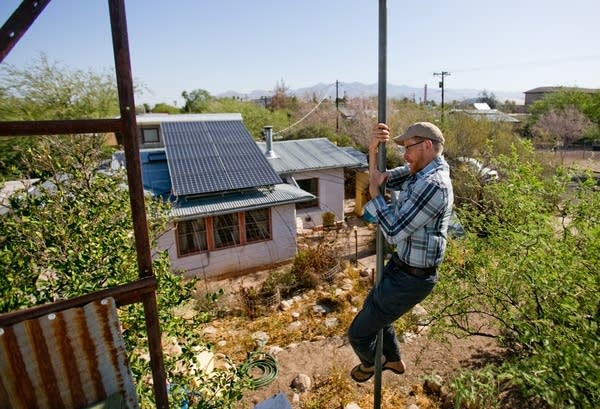Rain Man: How one Tucson resident harvests the rain

Go Deeper.
Create an account or log in to save stories.
Like this?
Thanks for liking this story! We have added it to a list of your favorite stories.
Fourth in a series.
When it comes to rainfall, Tucson is not the beneficiary of Mother Nature's bounty. The desert city receives only about 12 inches of rain a year, and in the past decade, mired in drought, Tucson has been lucky to get 10.
But that's plenty for Brad Lancaster, perhaps the nation's foremost expert on rainwater harvesting and certainly a die-hard proselytizer. He catches every drop that falls on his rooftop and has used it to transform what was once a barren, sun-baked 1/8 acre city lot into an oasis overflowing with native plants, shrubs and trees.
• Beneath the Surface, a special Ground Level report
Turn Up Your Support
MPR News helps you turn down the noise and build shared understanding. Turn up your support for this public resource and keep trusted journalism accessible to all.
He recycles the greywater left over from his shower and washing machine to irrigate fruit trees. He's swapped out a water-guzzling toilet for a composting commode. He even drinks the rain, collecting it in a giant cistern. Lancaster talks of water as a crop, something to harvest to lessen the reliance of Tucson's burgeoning population on water sucked from the ground and imported from the Colorado River.

"Let's plant the rain," he said. "Plant and reuse greywater, in a way that dramatically reduces or eliminates our need to pump water in the first place."
That's a strategy that could find fertile ground even in water-rich Minnesota, both as a way to conserve groundwater in parts of the state that are pumping it faster than it's being recharged, and as a means to control flooding in a changing climate, says Ali Ehassan, manager of water supply planning with the Metropolitan Council in the Twin Cities.
"In many places we're starting to see intense rainfall events that prevent us from recharging the aquifer, have huge runoff, causing floods, that will be the biggest factor that will change our water management."
A living laboratory
"Let's plant the rain. Plant and reuse greywater, in a way that dramatically reduces or eliminates our need to pump water in the first place."
Lancaster's ultra low-impact lifestyle starts with the roof over the tiny 200-square-foot converted garage he calls home. His brother and sister-in-law live next door in the property's larger, more conventional home, in a neighborhood of modest, one-story houses near the University of Arizona.
Gutters underneath the slanted metal roof funnel rainwater into two 1,000-gallon tanks. The first flush of water off the roof, containing bird poop and dust, is filtered with small screens. The tanks are shaded so algae won't grow, and because the roof and gutters are made with non-toxic materials, Lancaster drinks the water straight from the collection cisterns.
"You've probably heard of the local food movement?" the tall, red-bearded 47-year-old asked as he took a hearty swig. "This is the local water movement. It doesn't get any more local than the rainwater coming off your own home's roof."
It's legal to collect the water that runs off roofs in Arizona, Minnesota and most other states, but not everywhere. In Colorado it's against the law for homes connected to water and sewer systems. The rainwater there is reserved for owners of downstream water rights.

Lancaster, who's traveled the United States and the world consulting on how to conserve and capture water, says rainwater is known worldwide as sweetwater, "because it's never hit the soil surface, it's never picked up the salts and minerals you would find in ground and surface water."
But the bulk of the water Lancaster collects is used to irrigate gardens in the winter and landscaping and fruit trees during the remainder of the year. Between 30 and 70 percent of a typical household's domestic water is used to irrigate home landscapes, he said.
The only city water he uses feeds a washing machine and shower. But even that water is used again. Next to his washing machine four pipes are labeled with four different fruit trees: olive, pomegranate, orange and fig. Each time he washes a load of laundry, he selects the tree he wants to irrigate. Similarly, his shower has three drains, each funneling water to different areas.
"It's a guilt-free shower," he says, "because the water's not going to the sewer, it's going to grow the landscape."
Transforming a neighborhood
Lancaster hasn't confined his water harvesting to his property. He's taken the same strategies out into the streets, where he tired of watching the asphalt funnel torrents of stormwater away during Tucson's summer monsoon season.
So several years ago he started cutting small gaps in street curbs to allow rain water to rush off the street and into basins he dug along the sides of the roadway, which he mulched and planted with shade trees and native shrubs.
"When we started this, it was illegal," he conceded. "So we did it on a weekend, when no one from the city was watching."
That first cut worked so well, he started making more. Then his neighbors noticed how well plants responded, and soon they wanted to cut the curbs bordering their properties.
So Lancaster called the city. "I was nervous initially," he recalls. "Because I knew some of our strategies were breaking the laws at the time, and I feared it would be a difficult situation working with the city."
But he found Tucson officials receptive. It took a lot longer than he had hoped — three years — but eventually the city made the process legal.
Now three quarters of the homeowners on his block have cut holes in their curbs to collect stormwater. His six-block neighborhood collects over 600,000 gallons of water a year that previously just flowed away and eventually evaporated.
And what began as a covert experiment in one modest neighborhood is now poised to expand city-wide, thanks to a groundbreaking new "Green Streets" (PDF) ordinance passed by the Tucson City Council in 2013. It requires new street projects to capture the first half inch of rain during a storm.
"It's a radical shift," Lancaster said. "Because in the past, streets have been designed to drain 100 percent of the rain falling on a street. Now it shifts the streets from a drainage strategy to harvest strategy."

Tools for Minnesota?
Lancaster says his strategies are applicable far beyond Tucson, any place there's a dry season or periods of drought. That's why he's added the words "And Beyond" to the title of the how-to bible he authored, "Rainwater Harvesting for Drylands."
In Minnesota, the capture of rainwater and stormwater is becoming more commonplace as strategies to protect the water quality of lakes and rivers and mitigate flooding, and increasingly, for irrigation.
Several rain gardens have been built around Duluth to prevent water from rushing down the steep hillside and sweeping pollutants into Lake Superior. Several cities, including St. Anthony Village and Centerville, are harvesting water to irrigate parks and ball fields. There's even a 200,000-gallon cistern underneath the warning track at Target Field that collects stormwater to water the outfield.
• Chat: How important is stormwater reuse?
Lancaster said he gets jealous when he travels to wetter regions and sees the vast resource that rushes away with each rainfall.
In Tucson, he said he's seen a sea change in just the past decade. A few years ago "people would look at you with a blank look on their face" when you mentioned rainwater harvesting.
Now, the city of Tucson has in place a $2,000 rebate for homeowners who invest in rainwater collection systems. And the city council passed an ordinance requiring new commercial developments to irrigate at least half their landscaping with rainwater.
But Lancaster isn't satisfied. The vast majority of rain that falls on Tucson is lost to evaporation, he said. "In my opinion, we need to make rainwater the primary irrigator of all landscapes."





